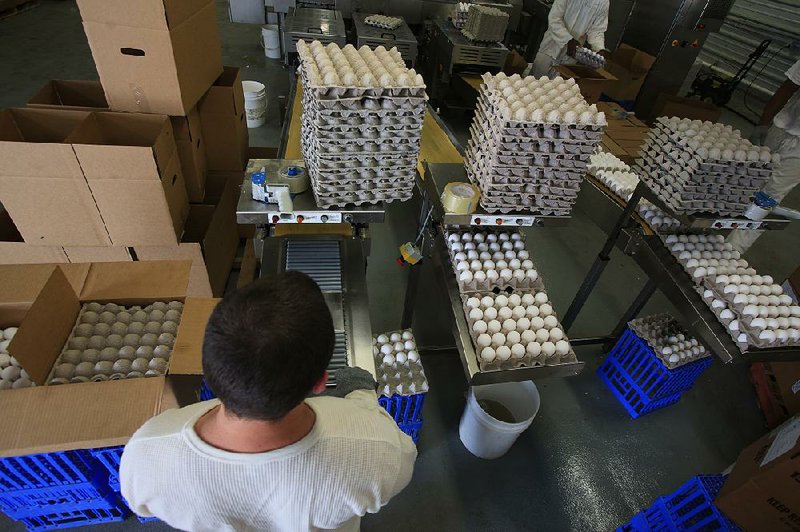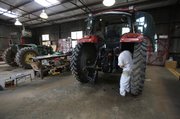Arkansas prison inmates head out to the farm — some driving large equipment, others packaging thousands of pounds of vegetables and grain, or meticulously picking through 100,000 eggs a day.
The Arkansas Department of Correction prison farm — consisting of about 21,500 acres spread among five prison facilities — has a $20.4 million annual budget and generates about $6 million in crops sold to outside vendors and another $8.7 million in food consumed by inmates each year.
The inmates, who are not paid for their labor, earn training certifications that translate into job skills that can be used on the outside.
But some state legislators and farmers are raising a question: Is the prison farm model a relic of a bygone era no longer feasible or necessary in the 21st century?
“Do we still need to be in the farming business?” asked Sen. Eddie Joe Williams, R-Cabot. “We do need to be gardeners. There’s no question about that. But should we be competing with other private farmers?”
Arkansas legislative auditors were on prison grounds recently, poring over budgets, reviewing processes and delving into every aspect of the prison’s agriculture division. A legislative panel invited the group in September after signing off on a request from Williams to help lawmakers decide whether it makes sense for the program to continue.
Jon Moore with Arkansas Legislative Audit said the auditors are performing the farm’s regular financial audit as well as the special report at the same time.
“It will be finished no sooner than March,” he said.
PRISONS OF THE PAST
The state-run prison farms came into existence in the early 1900s as an answer to the “convict lease system” — which had been used since the mid-1800s but was officially signed into law in 1872. The state profited by “leasing” inmates to private businesses, railroads, mines and farms. The system, however, was fraught with neglect and abuse.
When Arkansas established its prison system in 1838, it did so with the caveat that it must be self-supporting and get no state assistance.
The prison farms — which began with the $140,000 purchase in 1910 of 10,000 acres near the Delta town of Gould, about 60 miles southeast of Little Rock — allowed the prison system to glean a profit and give the inmates an opportunity for physical exertion.
Early photographs of what is now the Cummins prison farm show inmates in white jumpsuits, backs bent picking cotton and dragging long canvas bags behind them. Guards stand sentry on horseback.
The Cummins Unit has a checkered past.
Gov. Winthrop Rockefeller declared in 1967 that the Cummins Unit was “probably the most barbaric prison system in the United States.”
Inmates were subjected to regular beatings and other corporal punishment measures. Also, a select group of inmate guards who carried shotguns and pistols were allowed free rein in overseeing the farm workers. They not only inflicted brutal punishment on their lower-ranking fellow convicts, but they also used bribery to control the food and mail distribution.
In 1970, a federal investigation into the Cummins Unit exposed a prison hospital that doubled as a torture chamber. Punishments included pain inflicted by bullwhips and electronic devices. Later that same year, the U.S. Supreme Court ruled that the Arkansas prison system violated the Constitution’s prohibition against cruel and unusual punishment. The farm was placed under federal supervision for the next 13 years.
When farm income dropped in 1971, board members at that time blamed the fact that “the strap” was abolished. In a 1971 Arkansas Gazette article, board Chairman John H. Haley said the most “efficient” way of running a farm with unwilling labor was by “whipping hell out of them.”
FARM LABOR NOW
A sea of eggs, some pristine white and others speckled with feathers, dirt and manure, snake along the red bumpers of the stainless-steel processor in the prison’s poultry operation.
Along the way, inmates in white suits stand sentry. One picks up an egg, inspecting it. He finds it inferior and tosses it in the trash. Down the line, an inmate sitting on a stool watches an electronic screen as a dozen or more eggs make their way under a small, blue-plastic curtain to a table lighted underneath.
The inmate scans the image on the screen, then points to an egg.
“We can’t sell a double yolk,” he says. “We send ’em to the units.”
He shrugs when asked if he likes the work.
“It gets me out,” he says.
Each week, 350-400 inmates are selected on the basis of “experience and attitude” to work on the farm, Correction Department spokesman Cathy Frye said.
The inmates are not paid for their labor, and there is no cap on their daily hours. Hot meals are taken to a chow hall at the farm office where inmates have about 30 minutes to eat before they head back to work.
The operation requires constant vigilance. There are more than 2,000 head of cattle to be fed and cared for, 2,400 hogs, 396 horses and about 221,000 chickens. About 400 dairy cows have to be milked morning and night.
Combined, the five prison farms — Cummins, Tucker, East Regional, Wrightsville and North Central — have about 21,500 acres of cropland that’s used to grow corn, soybeans, rice, wheat, oats, vegetables and hay.
Hundreds work on hoe squads overseen by correctional officers on horseback.
There is a cold-storage facility and a slaughterhouse to process meat, and a vegetable-processing facility, all of which require dozens of inmate workers.
A “hot/cold” weather policy that restricts work for inmates on other work detail does not apply to farm laborers. There are no designated break times, but they are allowed “as needed.”
“Just like at a free-world farm, animals must be cared for regardless of the weather,” Frye said.
The prison farm system is an agriculture job-training forum, said Arkansas Agriculture Secretary Wes Ward.
“Prisoners are in there learning skills and, if they do leave prison, they’ve got a way to make themselves productive citizens,” Ward said. “There is a need for agriculture workers. Just like most other fields, agriculture has become more technical. The machinery is bigger and more complicated. The inmates are learning skills that they might not have had prior to being incarcerated.”
In Texas, its state prison farm — all 139,000 acres in 47 Texas counties — is operated much the same way. Its 2,500 inmate farm laborers are not paid and are selected on the basis of a classification system.
“When offenders come into the system, they are interviewed, and information is gathered relevant to family structure, criminal and social behavior, drug and alcohol involvement, military and institutional experience, as well as education and employment history,” said Jason Clark, director of public information for the Texas Department of Criminal Justice.
“The results of the tests and interviews are the basis for classification decisions that determine the unit of assignment, the level of security supervision, housing and job assignments, and time-earning status.”
One thing that differs between Texas and Arkansas, however, is that the income generated goes back into the Texas prison system as a whole.
The Arkansas prison farm income — $16.5 million annually — stays on the farms.
CULTIVATING MONEY
When a white bus with black-lettered “Department of Correction” on the side screeched to a halt in front of the prison’s pullet house in early November, nearly two dozen people dressed in white, paper jumpsuits with clear plastic over their shoes filed out and lined up in front of Farm Manager David Farabough.
The members of the Senate and House State Agencies and Governmental Affairs committees were there to see for themselves what the prison farm brings to the table.
Farabough answered questions from concerned legislators about the incident in August that left 41,000 chickens dead after they suffocated when a tractor driver hit poles that knocked out power to the facility. The backup generator also failed.
“It was just the perfect storm that day,” Farabough said. “We’re having another, bigger generator installed, and we now test our generators every Wednesday to make sure it never happens again.”
Farabough then motioned the group to a rubber-mat container filled with water in front of the pullet house, where baby chicks are kept.
“We have to take precautions against the Avian flu and salmonella,” Farabough explained as he motioned for the first few in line to dip their plastic-covered feet into the water.
Throughout the tour of the farm facilities, the lawmakers peppered Farabough with questions.
What would the prisoners eat if they weren’t served eggs from the farm?
“Inmates are fed two eggs per day. If not for this farm, they’d be eating powdered eggs,” Farabough said.
How much of what the farm produces goes back to the prison for inmate consumption?
“Two-thirds,” Farabough answered.
The annual cost to feed an inmate is much lower in Arkansas compared with many states, according to statistics from the Bureau of Justice. Arkansas spends about $424 per inmate per year compared with other Southern states like Georgia, which spends about $1,150 per inmate, or Oklahoma, which spends about $1,011 per inmate on food each year.
The farm operates on its own without any cash from the prison system’s accounts or from state funds.
The income it generates is reinvested entirely in the prison farm.
Expenditures — which include money for salaries, travel for conferences, and large equipment purchases and maintenance — are about $21.1 million each year. About $2.6 million is budgeted annually for 64 civilian salaries — which include Farabough’s $73,000 — and are paid out of the farm budget.
In the cold-storage area, legislators hammered Farabough with questions as he explained the cattle process. Cattle raised on the farm are not slaughtered for inmate consumption but instead are sold in Oklahoma City through National Stockyards.
The money from the sales is then used to buy back a lesser-quality beef at a cheaper price. That cheaper beef is extended with soy protein and fed to the inmates.
“This is the best use of the taxpayer resource. Inmates do not get the best-quality beef,” Farabough said. “If we slaughtered our beef, there would be ground steak being fed to inmates. I am not sure the taxpayer that can’t afford that wants to feed that to an inmate. We sell hide, horns, feet and internal organs for premium price. We buy back only beef cheaper. It’s a good deal for the taxpayer.”
But a state agency selling cattle to out-of-state buyers instead of in-state has some Arkansas cattle buyers upset.
“I’m a tax-paying Arkansas citizen,” said Darrell Ford, owner of Hope Livestock Auction Inc. “A lot of our money goes to the prison system, as does everybody’s in the state of Arkansas. When they sell in another state, that commission is going to someone else. They ought to be selling them in Arkansas and keeping the money here. I feel very strongly about that.”
Board of Corrections member Mary Parker-Reed told legislators in November that the farm is self-supporting and has to look for ways to make a profit.
“We are just like any other cattle rancher out there trying to get the highest yield,” Parker-Reed said.
For people like Williams, the legislator from Cabot, the question remains: Should Arkansas be in the farm business competing against its own residents who make their livings in agriculture, the largest industry in the state?
“It made sense 50 years ago,” Williams said. “But we were labor-intensive then. We’re not labor-intensive anymore.”
Some information for this article was obtained from newspapers’ archives and from the Encyclopedia of Arkansas History & Culture.



